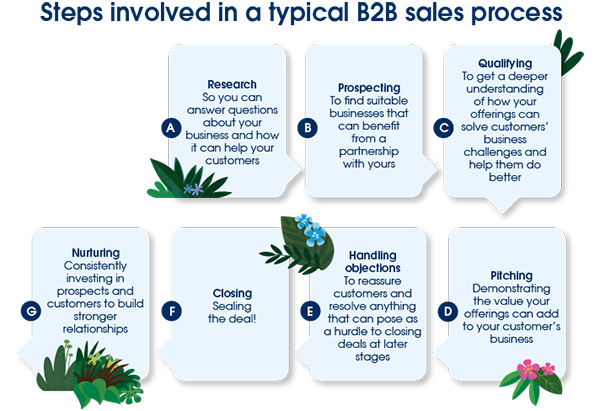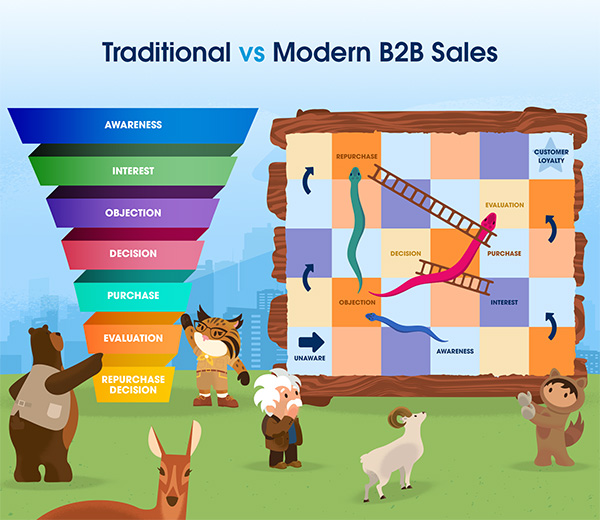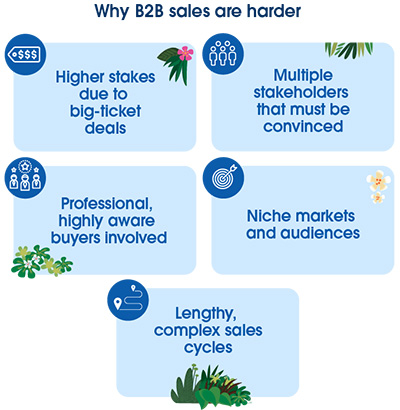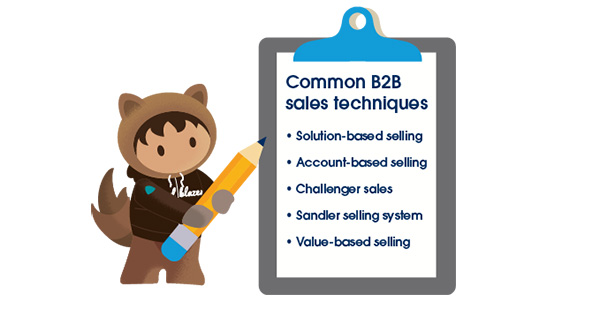Get your FREE 30-day trial.
Start by selecting a product:
Isn’t business to business (B2B) sales just like any other type of sales? In the simplest sense, maybe this statement is true. But in the real world, B2B sales is very different from business to consumer (B2C) sales. In the battleground of B2B sales, salespeople face multiple decision-makers, lengthy closing times, and complex sales cycles.
Helping other businesses realise what they need to be successful, and fulfilling these needs with your offerings and solutions is B2B sales.
With the digital age, the traditional model of B2B sales has been disrupted by changes in the way people purchase goods and services. Internet penetration and the consequent explosion in easily accessible knowledge and networking have affected B2B sales as much as anything else. But in every change, there is opportunity.
B2B sales involve one business selling goods and/or services to another business, as opposed to selling them directly to end consumers. B2B salespeople need to be more convincing and good at negotiating, as business buyers are highly evolved and deal sizes can be huge. They must thoroughly understand their prospect’s organisation, needs, challenges, and industry. The role of B2B salespeople has evolved from simple selling to something more consultative, making them advisors to their customers.
The B2B sales process is a series of steps that is meant to take a business buyer from the initial stage of discovery to a closed sale. It requires a well-thought-out strategy and the use of sales techniques suitable for each target persona.
Every organisation will need a slightly different B2B sales process involving anywhere from five to eight steps. A typical eight-step sales process consists of:

A B2B sales funnel is the sales process from the customer’s perspective. Like the sales process, the sales funnel too can have multiple stages. But today, this customer journey is not linear. Customers spend a significant amount of time researching and discussing their options with friends and colleagues. By the time a salesperson is involved in this journey, customers may even be close to a decision.
A typical B2B sales funnel involves these stages:

The most obvious difference between B2B and B2C sales is the nature of the customers. Selling clothes to a customer is a completely different process from selling industrial textile looms to a manufacturer.
For B2B sales, professional buyers or executives from various industries are customers. Anyone can be a customer for business to consumer sales.
The differences in the customers’ nature also create differences in their decision-making and purchasing processes. Business buyers make purchases based on rational, strategic bases to generate further value. In contrast, consumer buyers can make decisions based on reasoning, emotions, desires, or personal values.
The difference in purchase decisions calls for B2B and B2C salespeople to adopt very different sales tactics and marketing strategies.
Here are some key characteristics of B2B sales:

In B2B sales, relationship building through constant nurturing is needed to ensure repeat business. Getting new customers costs 5-10 times more than keeping existing ones. Since B2B sales typically involve bigger deal sizes and complex processes, repeat business becomes crucial for your business’s predictable growth.
Not that repeat sales don’t matter in B2C sales. However, relationship building in B2C sales is done at a personal, emotional level, and involves smaller purchase values than B2B sales.
Making B2B sales requires you to follow the same loose framework for making any sale. Build a sales strategy that is well-suited to target your ideal customer, break it down into repeatable steps that your sales team can follow, measure performance, and make improvements as and when needed.
The difference is in the way you approach your prospects and customers and how you align your selling model with their purchasing process.
Try to make your sales process as convenient, fast, and transparent as possible. Salespeople also need to have a good understanding of what they sell. B2B customers do not appreciate their time wasted, and showing a lack of knowledge and experience will not inspire confidence.
Research well and get to know what they sell, to whom, which markets, etc. Understand the role of each stakeholder and their individual challenges and needs. This can help you hyperpersonalise your pitch to show how your offerings can address multiple pain points and goals. In addition, automating parts of your sales cycle is an effective way of making it faster.
Within a basic sales process, sales teams can employ one or more of the following sales techniques to increase their chances of succeeding:

No matter the sales techniques used, all B2B salespeople can benefit from the following tips:
Inside B2B sales is made remotely by reps sitting in an office (or any location), whereas outside B2B sales is those made by reps in the field.
Outside sales tend to be more successful because of the personal touch salespeople can add by interacting with customers directly. Outside salespeople might close more sales and drive order values up. However, outside sales is more expensive and time-consuming.
With a wide variety of communication tools now available to salespeople, selling from anywhere is increasing in popularity, more so since the pandemic struck. Inside sales cost less and give managers more control and better oversight of the sales process.
B2B sales has undergone a dramatic change in recent years. Business buyers now have access to a lot of information about products, services, and suppliers. They also have a wide range of options to choose from. This makes the B2B sales space more competitive and requires B2B salespeople to engage customers more meaningfully.
Business buyers now expect a highly personalised purchase experience. To deliver this, salespeople must possess an intimate understanding of the needs and desires of buyers. Salespeople can also leverage technology to conduct better research about a prospect and their organisation or industry.
Sellers also have access to a range of B2B sales tools that they can deploy, including data analysis tools, sales reporting and tracking, B2B marketing automation and targeting programs, and sales management and forecasting software. These tools improve the efficacy of sales teams, helping reps move clients along the sales funnel faster and more successfully.
B2B sales has changed, but for the better. With more tools at the disposal of both buyers and sellers, salespeople can proactively reach out to prospective buyers at the right time. With business buyers expecting highly personalised purchase experiences, salespeople need to leverage data-driven tools and their social skills. Addressing the needs of business buyers and forging lasting relationships with them is the key to success in B2B sales.
Now more than ever, it’s important to build deeper connections with customers, manage your business in real time, and adapt fast as the world continues to evolve. Learn how Sales Cloud can help you grow your business and bring out the best in every rep.
This post was originally published on the Salesforce I.N. blog.